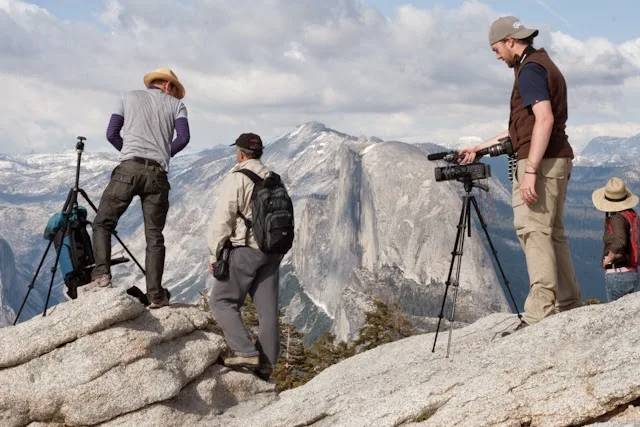Photographs in the Geological Works
Photographs are a key part of most geological fieldwork. They can serve as an aide memoire , be used for image analysis to document changes in an exposure over time and are also essential to illustrate key geological features in a report, talk or publication.
As outlined in this Section. it is very important in the field not only to take a photograph but also to make field notes and sketches, because a photograph is not a replacement for a field sketch. A field sketch records how you have divided up the succession, provides a key to further notes and shows some geological interpretation. The photographs taken should be recorded in your field notebook and electronic information on the geological features and location added either through the camera or image processing software.
The
detailed advantages and disadvantages of the wide range of cameras available on
the market are outside of the scope of this book, so here we provide some
general comments. Digital single - lens reflex (SLR) cameras provide the most
amount of flexibility for a range of lighting conditions and types of photograph;
they also generally have better lenses. However, many compact cameras give
excellent results and have the added advantage that they are small and light.
As with Personal Digital Assistants (PDAs), etc. check if the screen is visible
under strong lighting conditions. This is essential when the camera does not
have a view finder.
If the camera does have a view finder but is not an SLR, the view finder does not usually give an exact representation of the frame of the photograph so you may need to work out exactly what that is if you wish to frame your subject exactly. Even with digital SLRs the view is not exactly the same. Cameras with good reviews for outdoor and scenic use will probably give the best geological field photographs.
A good macro lens setting is
advantageous if you are going to take a lot of close up photographs. In
addition cameras that are sensitive to a wide range of lighting conditions
allow maximum flexibility. There is almost no limit to the number of
photographs you can take with a digital camera, provided that is you have
enough memory and battery capacity for the camera. This means you can take
many more photographs than you will eventually use.
The following
tips may help give you a set of photographs that cover all eventualities.
Make the first photograph at a locality a general view; this will remind you of where the photographs that follow on were taken.
Take both general views and close - up views of different features.
Take note of the lighting conditions. The best view under sunny conditions is often with the sun behind you, so this may mean returning to a locality at a different time of day to get the best lighting. Cloudy conditions provide a more even light, but sunny conditions can show some geological features better.
If the lighting conditions are poor or variable take several shots with different settings. Note that underexposed digital photographs can be processed later to achieve a good image whereas overexposed photographs do not record all of the information. In Figure, (b) is better than (a).

(a) Auto setting. (b) After using a white balance card to adjust the balance for the lighting conditions (seek advice from professional photographer/ photographic shop).
If you are using the photograph for image analysis ensure that it does not have any edge distortion, for instance that produced by using a wide - angle setting, or taking photos with the lens set to 50 mm or longer focal length. You will also need to take account of white balance under different lighting conditions.
Under low lighting conditions a tripod is useful; if you do not have a tripod with you try setting the camera up on a rock and using the self-timer or a remote shutter release.
If you are working where weather conditions are bad consider purchasing a waterproof camera case of the type used by divers for underwater photography.
If you are taking a lot of photographs, for instance of shell beds or fi ne - scale detail, take the photographs in stratigraphic order to avoid confusion and consider marking the rocks in some manner, for instance with a marker pen, correction fluid or a tile scribe, so you know how the different photographs relate to each other.
In most instances it is best if you stand perpendicular to the object being photographed.
You can use the white pages of a notebook to reflect light into the shadowed portions of exposures, especially under overhangs.
Include a scale or make a note of the size of the area being photographed. Depending on the subject of the photograph this could be anything from another person to a ruler, camera lens cap, coin or penknife. For small – scale photographs a finger is also useful and one of the advantages of this is that you will not inadvertently leave it behind! Ideally with medium and small objects use a metric scale rather than an object such as a lens cap or coin because these have variable dimensions. In addition the scale should preferably be of a neutral colour (grey) so that it will not unduly affect photographic exposure. Alternatively draw a scale on the cover of your notebook with a bold marker pen.
When taking a photograph of an area you have sketched consider including the field notebook page in one corner of one of the photographs as a means of cross referencing between the photographs and your field notebook (assuming the field of view is appropriate).
Assuming you are using a digital camera check, using the camera display screen, the exposure and as far as possible that the focus is OK before you leave the locality so that you can take another photograph if necessary.




%20(1).webp)





